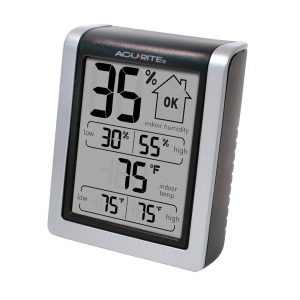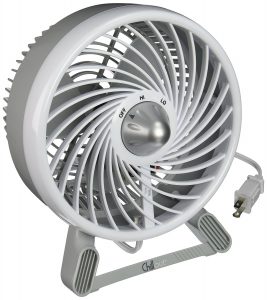Some of the links on this page may be affiliate links. Click here to learn more.
HUMIDITY & AIR MOVEMENT
For beautiful, thriving orchids, provide your orchids with humidity. Without adequate humidity, the leaves will shrivel – despite watering the orchid’s roots. To give my orchids proper humidity and air circulation, you will need three tools: a humidifier, a humidistat – a little gadget that tells the humidity and temperature – and a fan.
Humidifier
This humidifier will do a lot more to raise humidity levels for your orchids than a tray of pebbles filled with water under your orchids. This humidifier is quiet and has a large 2-gallon tank. The dual top-fill tanks make it easy to re-fill. And, if you ever need to warm up your orchid environment, you can turn on a warm mist.
Egg Crate
This is a product I wish I’d purchased a long time ago. Place your orchid pot on top of the egg crate for drainage and added humidity.
EGG CRATEHumidistat

This humidistat makes tracking high and low temperatures and humidity easy. The pores on an orchid’s leaves are called stomata. These pores open, allowing the orchid to breathe. Without proper humidity levels, this process will dehydrate the orchid. On the other hand, ideal humidity results in thriving, amazingly beautiful orchids.
Govee Indoor Hygrometer Thermometer
The Govee H5075 thermometer and hygrometer is essential for growing orchids, as it provides accurate real-time temperature and humidity readings. These factors are vital for orchids’ growth and health. The smart app alerts and large LCD display enable you to monitor and adjust conditions quickly. Its data storage and export features also help you track long-term trends, ensuring optimal care for your orchids.
Fan

By providing your orchids with proper air movement you will be able to protect your orchids from a host of bacteria that may grow on the orchid’s leaves as well as temperature changes.
Spray Bottle
A spray bottle always comes in handy for the orchid grower, and this spray bottle with a continuous mist is especially useful. When using a spray bottle it’s important to mist the roots, rather than the leaves – which can lead to bacterial spotting.
CONTINUOUS SPRAY BOTTLEImproving Water Quality
Below are links to Amazon.com for products that you can use to improve water quality. CLICK HERE to learn about why water quality is important to grow orchids.
Products for testing and adjusting pH
Orchid roots best absorb nutrients when the pH of their water is between 5.5 and 6.5. Use these strips to determine your water’s pH.
pH TEST STRIPSAnother way to measure pH is with a test drops kit. Use can use either strips or drops, depending on your preference.
pH TEST DROPS KITAfter discovering your water’s pH, use the pH up or down to adjust your water’s pH. Keep in mind that adding fertilizer to your water will change the pH, so be sure to check the water if fertilizer is added.
pH ADUSTER KIT UP & DOWNJust as pH matters to your orchids, so does water hardness, or the quantity of minerals in your water. We call this Total Dissolved Solids (TDS). Click here and scroll to the end of the post to learn more about orchids and TDS and the best way to give your orchid healthy water.
WATER HARDNESS TEST KITDigital pH Tester + Digitial TDS Tester Combo
Note: I find the digital testers more fiddly to use than the strip/drop tests as they must be calibrated for accuracy.
DIGITAL pH AND WATER HARDNESS TESTERSProducts for Collecting Rainwater
Here, I am linking to a page with several results on rainwater harvesting so that you can choose what works best for you.
CLICK HERE FOR RAINWATER COLLECTION PRODUCTS
Products for a Reverse Osmosis (RO) System
Again, I am linking to a page with several results for an RO, water purification system. Choose the one best suited for you.









